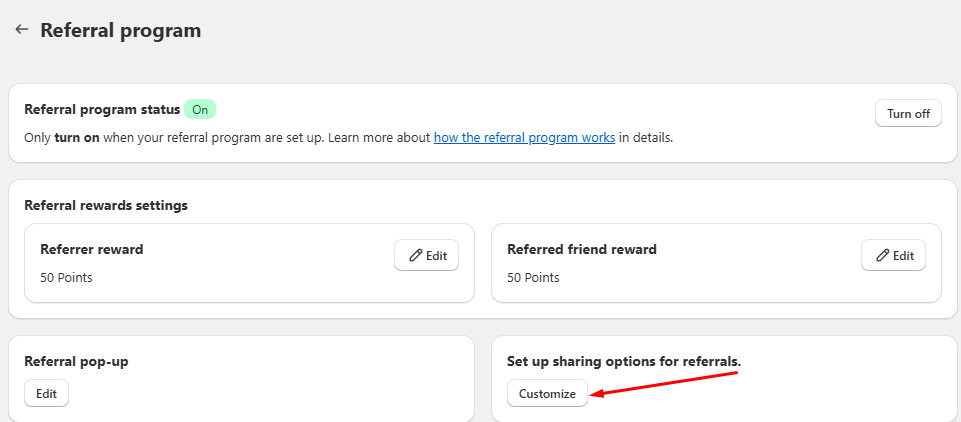Leave a review – LAI
26 April, 2022Setting up the new POS UI Extension
9 June, 20225 key steps to set up a successful Loyalty program
Learn 5 essential steps to launch a Loyalty program that drives engagement and repeat purchases
Introduction
The heart of a successful loyalty program is motivation, and nothing speaks louder than points.
Why? Well, points are like the dopamine hit of loyalty – they’re addictive, instantly rewarding, and give merchants the flexibility to customize rewards. Here’s why your customers will love them:
- Addictive nature: Customers love earning something tangible, and points provide that satisfying feeling of accomplishment.
- Immediate gratification: Every purchase gets them closer to a reward, creating a rewarding experience with each interaction.
- Merchant flexibility: Unlike fixed cashback, points let you decide their value and exchange rate, adding a dash of personalization to your program.
Read more about point-based loyalty program examples from Shopify here.
Overview
Step 1: Finding the right balance of point-earning ratio
So, how many points should customers earn per dollar spent? It depends on your cashback percentage. Keep it simple with this format:
Earning Points Ratio: $1 spent = X points (X is your ideal cashback percentage).
Example: If aiming for a 5% cashback, the setting should be $1 spent = 5 points.
You want to be generous, but not break the bank, right? A typical loyalty program usually dishes out 3% to 10% cashback. So, take a look at your margins and find that sweet spot that works for you.
Step 2: Set up your redemption rules
Whether it’s 1 or 10 points per dollar spent, make sure it aligns with your cashback percentage. Your settings should be as clear as day. So aim for simplicity when you set up your point cost.
Example for setting up the redemption rules
If you want to offer a 5% cash back, then this is how your settings should look:
Earning points ratio: $1 spent = 5 points.
In this scenario, when your customer spends $100, he or she will have 500 points in his or her account. Then, you can set up the redemption rules like this:
- 500 points = $5 off
- 1000 points = $10 off
Step 3: Set up the point-earning actions
Begin by offering at least 3 to 5 earning actions to encourage customer engagement. You can choose from our Earn Points tab overview here.
These are the most commonly chosen earning actions by BON merchants:
- Setting up an account (welcome points). We also offer a “Limited-time point offer” feature for the “Create an account” rule. Check it out!
- Sharing their birthday (birthday points)
- Completing an order
- Engaging on social media
Step 4: Choose how you will reward your members
Choosing Reward Types: Dollars Off or Percentage Discounts?
Using BON Loyalty, you have a variety of rewards to offer your customers, and the choice depends on what they value. It could be a percentage discount, a fixed or variable amount off, a free product, free shipping, and more!
You should start with these two (choose at least one). You can find out how to utilize them by clicking on each reward type name:
Do’s and don’ts when setting up your rewards
- Do: Ensure your discounts are easy to get. Ensure that redeeming a discount coupon requires a customer to purchase at least once but no more than three times (1-3 times). Consider your customers’ buying frequency and establish realistic rewards.
- Don’t: Do not allow members to gather sufficient points for rewards without making a purchase.
Encourage them to use their regular accounts, not just create new ones for discounts. Make sure the total points from social actions and sign-ups are less than what’s needed for a reward
Step 5: Introduce a Referral program
Boost your sales by creating a referral program in your store! Here’s a simple guide to get you started:
- Set the Incentives for the Referrer and the Referred friend
Decide on rewards for both the referrer and the referred friend. Ensure the rewards are tempting enough – offering around 10% to 20% of your average order value usually does the trick.
BON Pro Tip: Newcomers often prefer an amount-off discount upfront.
- Craft a catchy tagline for your Referral program
Choose a tagline that entices people to share your store with their friends. For example:
“Introduce a friend to [Your Store], and both of you get [X% discount] on your next purchase!
And here’s how the Referral program works. Start referring now and enjoy the benefits together!
- Enable social sharing and await more orders to come!
Make it easy for referrers by setting up social sharing features. Let the referrals flow and watch the benefits roll in.

And that’s it! You’re all set to unlock the full potential of your loyalty program. Remember, simplicity and engagement are the keys to a thriving loyalty community.